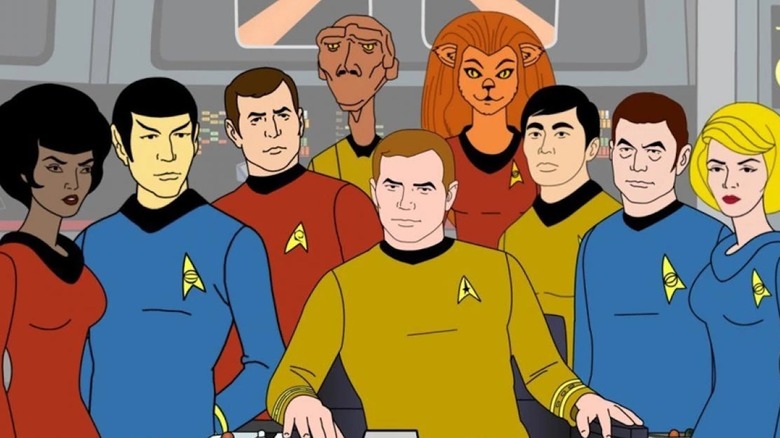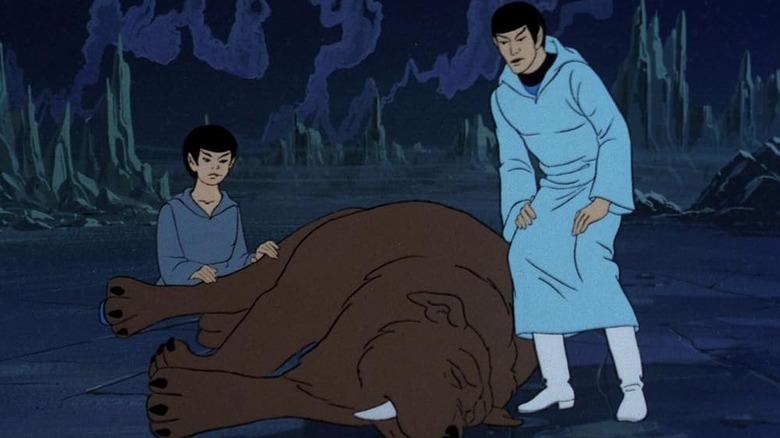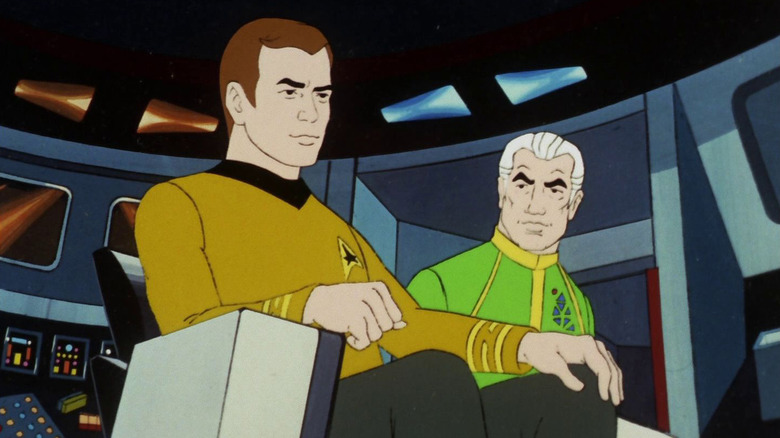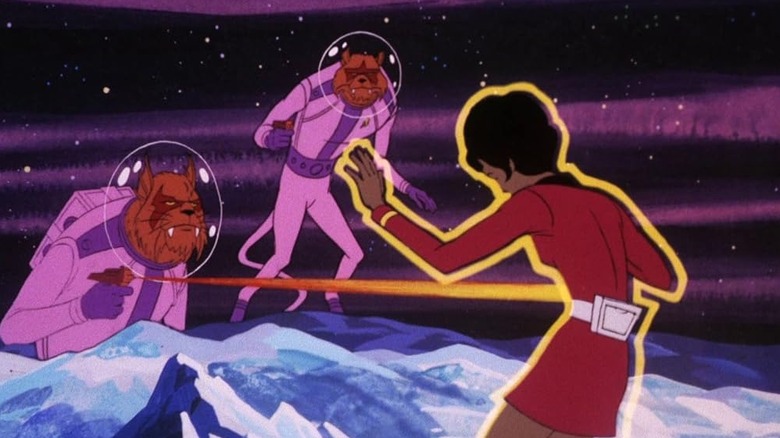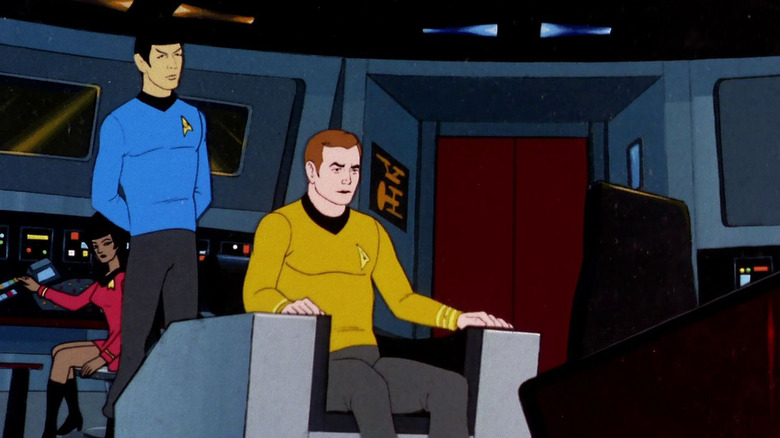5 Essential Star Trek: The Animated Series Episodes Fans Have To Watch
The original "Star Trek" series was canceled unceremoniously in 1969, and many probably assumed we'd never see Captain Kirk and the crew of the Enteprise again. But before "Trek" became a sprawling franchise with a dozen live-action spin-offs and just as many movies, its first revival came in the form of a children's Saturday morning cartoon, referred to these days as "Star Trek: The Animated Series." Nearly all of the original cast returned to voice their characters, yet debates have raged for years as to whether the events of the show are fully canon or not.
"Star Trek: The Animated Series" arrived in 1974, produced by Filmation — the same studio behind "The New Adventures of Superman," "The Archie Show," and in the '80s, "Masters of the Universe." Known today for its bonkers stories and more colorful characters, "Star Trek: The Animated Series" is the redheaded stepchild of the "Star Trek" family, but still holds a special place in the hearts of Trekkies for its uniqueness.
Few would call it a great show, and it boasts just 22 episodes in total, aired over the course of two years. Nonetheless, the series does have its highlights, with a handful of episodes that still stand the test of time half a century later. So wrap up your fun in the recreation room and strap on your life support belt, because we're going where no cartoon has gone before. Here are the five most essential episodes of "Star Trek: The Animated Series" that every fan should watch.
Yesteryear
"Star Trek: The Animated Series" isn't renowned for telling the same kinds of powerful, emotional stories as its live-action counterparts, owed largely to the fact that it was aimed at kids. Filmation was a notoriously low-budget animation studio, and the show had plenty of storytelling limitations, but none of that holds back what is generally considered the best episode in the series, "Yesteryear." Penned by "Star Trek" scribe D.C. Fontana, who wrote most of the best episodes of the original "Star Trek," the episode is also arguably the most important episode of the two-season series because it delves into the backstory of Mr. Spock, once again played by Leonard Nimoy.
"Yesteryear" sees the Enterprise visiting the Guardian of Forever from the iconic "Star Trek: The Original Series" episode "The City on the Edge of Forever." Spock steps through the portal and finds himself back on his home planet of Vulcan during his childhood. There he encounters his father Sarek (Mark Lenard) as well as his younger self. Posing as a distant family friend, the elder Spock accompanies his young self on a journey into the mountains — a journey that he remembers led to the death of his beloved pet Sehlat.
A poignant story about loss and grief, "Yesteryear" is a powerful episode in its own right. But it's also the rare episode of "The Animated Series" to be firmly entrenched in canon, and has been referenced numerous times in live-action, including the "Star Trek: Next Generation" episode "Sarek" and several episodes of "Discovery" and "Strange New Worlds."
BEM
"The Infinite Vulcan" is certainly not among the best episodes of "Star Trek: The Animated Series," but it might be one of the most important for a variety of reasons. For starters, it's the lone episode to be written by a member of the "Star Trek" cast: The script was penned by Walter Koenig, who played Ensign Chekhov in the original "Star Trek" but who wasn't able to return to voice the character due to budget limitations. That alone makes it a noteworthy part of "Trek" history; While many series regulars have received "story by" credits, it wasn't until Simon Pegg co-wrote "Star Trek: Beyond" that a cast member contributed a screenplay to the franchise.
The other thing makes "The Infinite Vulcan" special is its sheer weirdness. If you've never dipped your toe into the series before and want a taste of just how bizarre it could get, "The Infinite Vulcan" is the perfect place to start. In the episode, the Enterprise visits a world where Federation scientist Dr. Stavos Keniclius (voiced by James Doohan) has been performing odd experiments and causing problems for the locals, a plant-like alien race called the Phylosians. Upon investigating, however, they discover Keniclius is dead. A giant-sized clone has taken his place, and he proceeds to create a 50-foot-tall doppelganger of Mr. Spock.
A strange story that borders on laughable — which describes a lot of "The Animated Series" — "The Infinite Vulcan" surprisingly survived into canon decades later thanks to "Star Trek: Lower Decks." In that series, the crew of the USS Cerritos visits a cosmic collector who owns the skeleton of the giant-sized Spock.
The Counter-Clock Incident
For everything that "Star Trek: The Animated Series" does wrong — with off-the-wall stories that often make no sense, and static storytelling that makes it wholly unengaging — a handful of episodes do a lot right. One of the things the series did well was adding to the lore of the main cast, and in the case of "The Counter-Clock Incident," the Enterprise itself. Because this is the first time in "Trek" history that we meet the first captain of the Enterprise, answering one of the franchise's biggest questions.
When the episode opens, the Enterprise is hosting Commodore Robert April (James Doohan), who was the first captain of the Enterprise years before Kirk, and even Kirk's predecessor Captain Pike. But during the visit, the Enterprise is pulled into another realm where time runs backwards, and suddenly Kirk and the crew begin getting younger. By the end of the episode, it's up to April — now in the body of a young man — to save the ship, whose entire crew has been de-aged into infants and children.
A fun little adventure that has a high-concept, timey-wimey plot, "The Counter-Clock Incident" firmly establishes April as the man to launch the Enterprise. In 2017, "Star Trek: Discovery" made April canon, and he was finally seen on-screen (played by Adrian Holmes) in the first season of "Star Trek: Strange New Worlds."
The Slaver Weapon
"Star Trek" has long been popular among science fiction writing community, with Isaac Asimov going from critic to fan and eventually science consultant on "Star Trek: The Motion Picture." But Asimov wasn't the only big name in sci-fi literature to make a contribution to the franchise, with another of the '70s biggest authors, Larry Niven, writing the "Star Trek: The Animated Series" episode, "The Slaver Weapon." What makes this one even more interesting, though, is that the story incorporates characters from Niven's own "Known Space" book series.
Titled similarly to one of Niven's first stories in the series, "The Soft Weapon," "The Slaver Weapon" has the Enterprise attacked by the warlike Kzinti, a feline-like race of aliens who are on the hunt for a powerful cosmic weapon left behind by a long-dead civilization. Naturally, Kirk and the crew of the Enterprise try to stop them, and what follows is a back-and-forth adventure as both sides attempt to steal the device from the other. But the weapon itself has other plans, and the episode concludes with a genuinely surprising twist.
The Kzinti make their first appearance in "Star Trek" in "The Slaver Weapon," and they are referenced in later episodes of other "Trek" shows. But they were created by Niven as part of his "Known Space" series, marking a rare case of one fictional alien race belonging to two distinctly different franchises.
More Tribbles, More Troubles
During its two-season, 18-episode run, "Star Trek: The Animated Series" produced several episodes that saw the return of fan-favorite characters, or sequels to previous episodes. The best of them, though, is "More Tribbles, More Trouble," a follow-up to the beloved 1966 episode "The Trouble with Tribbles." The original adventure saw space merchant Cyrano Jones trying to sell hairy creatures called Tribbles, whose presence helps Kirk uncover a Klingon in disguise. That episode's writer, David Gerrold, returns to pen the sequel, which once again sees the Klingons getting involved with the mischievous furballs.
Like "The Trouble with Tribbles," the episode begins with the Enterprise transporting grains to Sherman's Planet. During the trip, however, they encounter a Klingon Battle Cruiser under the command of their old adversary Koloth (played in "The Trouble with Tribbles" by William Campbell, who later returned for one of the most underrated episodes of "Deep Space Nine"). Koloth is attacking a Federation vessel piloted by none other than Cyrano Jones. But to save Jones from a bitter fate at the hands of the Klingons, Kirk must figure out why they want him in the first place, and how it all connects back to those overbreeding Tribbles.
A silly romp in classic "Trek" fashion, "More Tribbles, More Troubles" doesn't reinvent the wheel, but has plenty of its own twists and turns. Like most episodes of the series, it's rather lightweight, but still a lot of fun. That it is a sequel to one of the most celebrated episodes in the franchise makes it all the more worthy of a watch.
